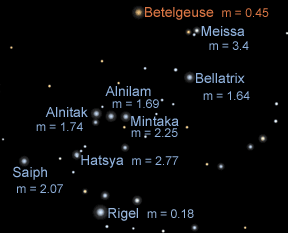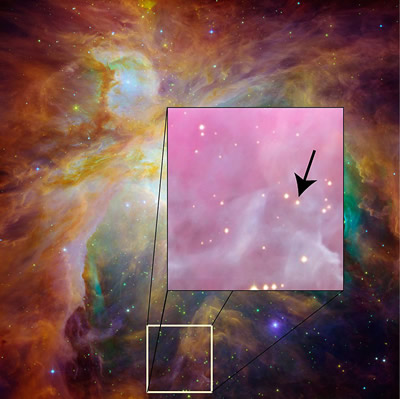Twin stars observed in the Orion Nebula. At this distance the twin stars appear as a single point of light.
Click on image for full size
Image Courtesy of NASA-JPL/HST and David James (Vanderbilt)
Newly Born Twin Stars are Far From Identical
News story originally written on June 18, 2008
Astronomers have always thought that twin stars, which are stars that have the same mass and orbit around each other, are identical. So they were surprised when they discovered that twin stars in the Orion Nebula were not identical at all. These stars actually have major differences in their brightness, surface temperature, and possibly even their size.
The newly formed twin stars are about 1 million years old. Since their full life span is about 50 billion years, they are equal to one-day-old human babies.
"The easiest way to explain the observed differences is if one star was fully formed about 500,000 years before its twin. That would be equivalent to a human birth-order difference of about half a day," said Keivan Stassun, one of the scientists who worked on this project.
You might also be interested in:

Would it be more difficult to pull an elephant or a mouse? If you pulled each animal the same amount, the mouse would come towards you but the elephant would not move at all, even if he didn’t try to
...more
Astronomers use a special term to talk about the brightness of stars. The term is "magnitude". The magnitude scale was invented by the ancient Greeks around 150 B.C. The Greeks put the stars they could
...more
Scientists have learned that Mount Hood, Oregon's tallest mountain, has erupted in the past due to the mixing of two different types of magma. Adam Kent, a geologist at Oregon State University, says this
...more
The Earth's mantle is a rocky, solid shell that is between the Earth's crust and the outer core. The mantle is made up of many different reservoirs that have different chemical compositions. Scientists
...more
Some faults look strong and like they wouldn’t cause an earthquake. But it turns out that they can slip and slide like weak faults causing earthquakes. Scientists have been looking at one of these faults
...more
The sun goes through cycles that last approximately 11 years. These solar cycle include phases with more magnetic activity, sunspots, and solar flares. They also include phases with less activity. The
...more
Studying tree rings doesn't only tell us the age of that tree. Tree rings also show what climate was like while the tree was alive. This means that tree rings can tell us about climates of the past. Two
...more















